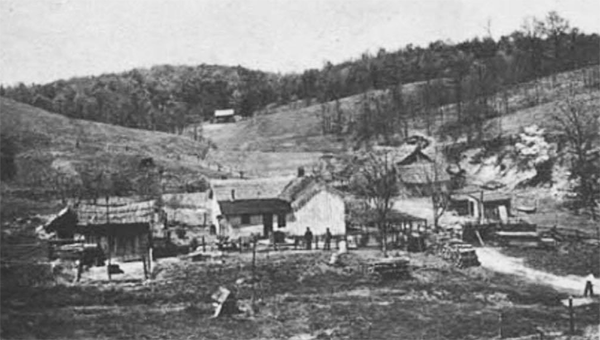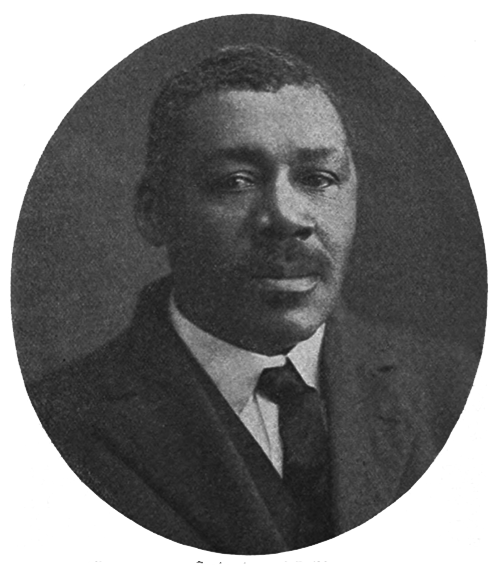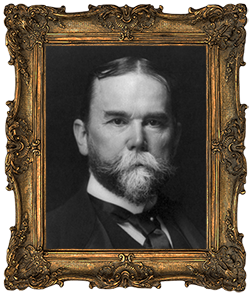Albert J. White - Prominent Contractor & Builder in Michigan
By: Jeremy Elliott, Washington County Historian - 2021
On Wednesday, February 6, 1861, (just two months prior to the Civil War), in the rural community of Canton, Indiana, a future, prominent and prolific builder of Michigan was born, into the household of Dennison and Emmaline (Newby) White.
From the best of my investigative abilities, it appears that Dennison White, walked to Washington County, Indiana, as a young boy, with his mother Sela, and eight siblings, from Perquimans County, North Carolina, in the mid to late 1820s. Formerly enslaved, Sela, had somehow gained or garnered freedom for herself and her children, and migrated here, determined for a better environment with better opportunities.
The inspiration for their migration to our area, I can only base off of an educated assumption. Since there was no apparent relation or connection, to the other White families listed in our Federal Census records, coupled with the particular area they chose to settle in, leads me to a near immediate expectation, of some prior or continued affiliation with a Quaker family, who lived in the adjoining Blue River Friends Community.
A large contingency of these Quaker families, also migrated here, from Perquimans County, North Carolina. Additionally, of the 27 black families listed in the 1850 Census, that had settled land between the eastern edge of Salem and into the town of Canton, nearly all had some known associations with the nearby Quaker Community.
Dennison spent the last of his formative years in this locale and began working as a farmhand, to assist his mother, with the household income. By the 1850 Federal Census, Sela and her son, Dennison, were the sole remaining inhabitants of their household, as apparently, the other children had grown up and moved on.
By the 1860 Federal Census, Dennison’s mother, Sela White, is absent from the county record. She would have been around 75 years of age at that time; this leads me to believe she either passed away, or she had relocated to be with one of her other children, for her remaining years. Lick Creek African American Pioneer Community - Orange County Indiana
Lick Creek African American Pioneer Community - Orange County Indiana
This may have occurred sometime after Dennison married Emmaline Newby, on October 7, 1858, near the Lick Creek Settlement, in Orange County. Approximately 20 years, or more, Dennison’s junior, she was also born in Perquimans County, North Carolina, circa 1838, before migrating to Orange County, Indiana with her parents, Solomon and Margaret Newby and her other siblings.
Also in the 1860 Federal Census, Dennison and Emmaline are listed as living in Canton, and having a 10 month-old daughter, named, Mary J.
Thus, Albert James was the second child born into this union. The couple would have another daughter, Margaret, (named for Emmaline’s mother), the following year. And by the summer of 1863, they were expecting, yet again. But according to their family tradition, in a story handed down from Albert’s great-granddaughter, Annette Taborn, this is when tragedy struck.
The relayed, old adage contends, that when Confederate General John Hunt Morgan and his Raiders invaded our county, in July of 1863, Dennison had a fateful encounter with some of the soldiers. After sacking and departing Salem, in the late afternoon, on July 10th, the bulk of Morgan’s Raiders turned East, down the Old Canton Road. Most or all of this military body, dallied around the old Royce’s Lick settlement, for a time, attempting to forage and intimidate our citizens into supplying dinner for the antagonistic soldiers, before advancing towards Canton.
Because the proclaimed event occurred during the darkest chapter of discrimination, in our county’s history, (Look for more information on this subject in future articles), the likelihood of it’s record or report is tenuous, at best, and I can find no evidence of it, whatsoever.
Nevertheless, in a family story handed-down, and quite likely originating with Albert’s mother, Emmaline; it is reported that Dennison White was shot and killed by some of General Hunt’s Confederate Raiders, when he attempted to intervene, with the soldiers stealing horses from the Canton area.
This reasonably, unregistered causality of that war, probably lies with hundreds, or possibly thousands, of others that went unrecorded. The likelihood of that possibility, probably increased significantly if the victim was black, regardless of locale. Just as feasible, would be the assumption that he would have been interred in the local AME Cemetery, located on what is now called, Jim Day Road, only two miles west of Canton. Regrettably, (due to that dark time in our county’s history that I just referenced), there is absolutely no way, for anyone to verify any aspect of our county’s black pioneer burials.
Naturally, this catastrophic episode, coupled with the hazards of remaining in an increasingly indignant, bigoted, and racially intolerable environment, led to substantial hardships for Dennison’s surviving family. A few years after delivering their fourth child in 1864, another daughter named Martha, Emmaline took her young children, and (just as nearly every other black citizen of Washington County during those times) began migrating North, in search of tolerance, opportunity, and survival.
When the 1870 Federal Census was taken, Emmaline and her four children are recorded as living in New London, Howard County, Indiana. This destination leads me to believe that the move may have been inspired, or assisted to some degree, by some of Dennison and/or Emmaline’s Quaker connections. This area became a vital part of the state’s “Underground Railroad” flourishing in pre-Civil War times and resulted in a sizable community of free black citizens on the western side of Howard County.
Apparently however, the move did not completely alleviate Emmaline’s financial difficulties, because later that year she removed 9 year-old Albert from school, and placed him in the custody of a local Howard County farmer. Sorrowfully, the 1870 census is the last record, I have been able to uncover, concerning any information in regards to Emmaline and her three daughters.
But Albert lived and worked with this man, on his Howard County farm for the next eight years, gaining considerable agricultural knowledge. At 17 years of age, an unknown motivation propelled him to depart his native state and travel into southern Michigan. Here, he gained employment with a white farmer in Richland, named Samuel Brown, just outside of Kalamazoo.
Reportedly, through this arrangement, the following year, he met a brick & stone mason, with whom he entered an off-season apprenticeship. For at least the next two years, Albert worked the growing season with Sam Brown and apprenticed, free of charge, for the mason, during the winter months. Albert continued with this arrangement for three years, as he is listed as a servant/farmhand, living with Samuel Brown, in the 1880 Federal Census. Albert J. White - Contractor and BuilderThe following year, Albert was listed in the Kalamazoo City Directory, as he left farming behind and entered the masonry apprenticeship, with the same unidentified mason contractor, on a full-time, paying basis. Over another three year period, Albert continued to receive extensive vocational on-the-job training, in every aspect of masonry and most of general construction. He would prove to be quite industrious and independently capable. Excelling in the field, he became a journeyman, at the age of 23.
Albert J. White - Contractor and BuilderThe following year, Albert was listed in the Kalamazoo City Directory, as he left farming behind and entered the masonry apprenticeship, with the same unidentified mason contractor, on a full-time, paying basis. Over another three year period, Albert continued to receive extensive vocational on-the-job training, in every aspect of masonry and most of general construction. He would prove to be quite industrious and independently capable. Excelling in the field, he became a journeyman, at the age of 23.
In 1886, at 25 years of age, Albert J. White became an independent contractor and opened his own construction business. On July 20th, of the following year, Albert married Miss Fannie Blanche Phillips, of Oshtemo Township, (which borders Kalamazoo). From 1888 to 1891, Albert and Fannie would have three children. Two boys, Orren Wesley and James Melvin, and the youngest, a daughter, named Vera May.
From 1886 to 1926, Albert grew his construction enterprise into one of the most successful building contractor businesses, in the Kalamazoo area. He regularly maintained over 50 employees, both black and white workers, and they were involved in a multitude of significant construction projects. His company built a half dozen, or more, paper mills in the Kalamazoo region. They also constructed the Illinois Envelope Company and the Clarage Fan Foundry & Machine Shop.
They put up the first addition to the Ascension Borgess Hospital, and the original brick addition, to the Villa St. Anthony, both in Kalamazoo. Albert’s company also erected a Jewish synagogue in downtown Kalamazoo, called the Temple B’nai Israel, dedicated in 1911. Although Albert’s building has been razed, this benevolent organization remains in Kalamazoo, and is celebrating over 150 years in existence. Additionally, Albert and his construction crew, built the third Kalamazoo Central High School and sizable additions to both, the Plainwell High School and Nazareth Academy (College). In September of 1905, they were also responsible for the dedication of the very first building on the campus of Western Michigan University.
Sitting atop Prospect Hill, (on a site selected by the same landscape architect who designed Central Park, in New York), the structure would house administrative offices, classrooms, laboratories, and a library. Clad in brick, the two-story building featured a portico, with six Greek pillars, an arch window over the main entry and a cupola, which would serve as a beacon of public higher education for the community.
Eventually, it became known as East Hall, and fell into an administrative role for the expanding school. In the 1940s, the center of the university shifted to the West Campus and the buildings on Prospect Hill were left largely unattended. East Hall became the university’s archive. In 1978, the building was placed on the National Register of Historic Places.
In an effort to clean up the old, dilapidated section of the university, in 2012, the board of trustees voted to raze all the buildings, with the exception of the original portion of East Hall. In December, they announced plans to turn East Hall, into the newly renovated WMU Alumni Center. The project was a clear indication the school was committed to preserving it’s birthplace and showcasing it’s historical relationship with the Kalamazoo community.
Albert White’s original construction, was incorporated into a new modern-marvel of architectural accomplishment, that opened in 2015 and garnered global recognition through the prestigious, 2018 Award of Engineering Excellence.
Both Albert and his wife, Fannie, became prominent, well-regarded assets throughout the entirety of Kalamazoo and were widely considered pillars of that city’s black community. They were known to be invariably helping the less fortunate and it is said that their home knew no strangers.
The couple amassed considerable property holdings, in both Oshtemo and Kalamazoo, and realized a true security of wealth.
When Albert was featured in a book published in 1907, titled, “The Progression of the Race,” it gave the following description of Fannie: “His wife is highly esteemed by the white people, being a member of that city’s Civic Improvement League, a strong organization of noted white women. She is frequently entertained in the best homes, in the area, and no color is known to her family.”
As is often the case with professional brick layers, as Albert aged, he began struggling with osteoporosis and degenerative arthritis. It is my investigatory conclusion that his medical condition, was the likely motivating factor that led Albert into retirement in 1926.
Another possible compounding aspect, was the fact that on June 20, 1926, Albert and his son, Orren, were involved in a pretty serious automobile accident, with two other cars, on Michigan State Highway 17, just outside of Albion. Both of the other participants in the accident, quickly filed suit against Albert for considerable damages, but I was uncertain if the plaintiffs felt Albert was to blame, or they simply just discovered who he was. At the trial, the jury ruled no fault, or no cause for action, and the case was dismissed. Unfortunately news reports of the incident, do not indicate any information regarding injuries sustained.
Albert’s medical issues continued to worsen, until he was hospitalized, on February 26, 1930. His aggravating degenerative complications, with his spine, led to avascular necrosis (AVN), a loss of blood supply to the bones. This malady, now commonly referred to as Kummel Disease, causes the bones to die and collapse from loss of nourishment. The death of tissue leads to infection, which invites the onset of sepsis and generally, fatality. The excruciating exacerbation of this illness, was the determining factor in Albert White’s death, on May 16, 1930.
The grief-stricken survivors had lost the cornerstone of their family’s foundation, the framer who built them up, and the mortar that bound them together. The community also suffered a devastating loss of leadership, a supreme ambassador of racial relations and a decidedly benevolent benefactor. After a substantial funeral, a mass of humanity followed his remains to their final internment, in the Riverside Cemetery, in Kalamazoo.
Fannie White would spend a considerable amount of her remaining years, living with her daughter and her family. She survived another 13 years, after Albert passed, before succumbing on August 15, 1943, from acute exacerbation of chronic myocarditis, (an inflammation of the heart). Of equal significance, and perhaps more public influence, her loss was another substantial blow to the entire Kalamazoo and surrounding communities. She was laid to rest beside her husband, in the Riverside Cemetery.
Additionally, I firmly believe that Albert J. and Fannie White’s familial legacy lives on in Kalamazoo, as evidenced by a tribute article to him, submitted by family members, that appeared in the 1999 Kalamazoo Gazette, in honor of Black History Month,(which is disappointingly inaccessible without a subscription). Or, at least, I certainly hope it does.
And so, in-spite of a prevailing, ignorant sentiment, against the black citizens of our county in those days, a great many would defy that ideology and become significant, monumental, philanthropic and historic contributors to society as a whole. Washington County’s black pioneers birthed such a generation of individuals, before they, and their history, were regrettably and unceremoniously eradicated from our borders.
Several of these notable natives, just like Albert James White, need to be rediscovered and have their legacies passed on to future generations.


